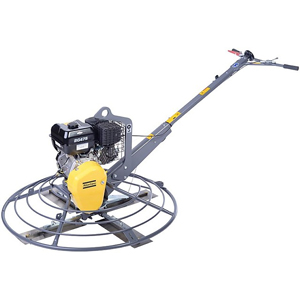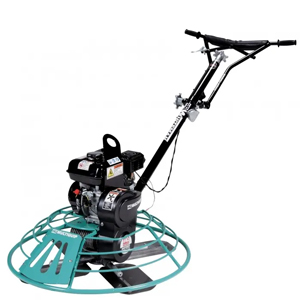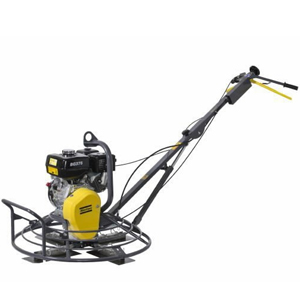The concrete walk-behind trowel is the tool that contractors rely on to create a flat and dense concrete floor. The trowel makes a smooth, dense floor by embedding aggregate and consolidating mortar at the surface. Every contractor uses their own technique when operating a walk-behind trowel, however, all contractors should take the same care of their equipment. Maintenance of a walk-behind trowel is easy, and a well-maintained machine will consistently deliver results for contractors. You can maintain your walk-behind trowel by following these simple steps.
A walk-behind trowel is made up of the blades that are in direct contact with the concrete. Additionally, the operator should ensure that the blades pitch at the same rate. Blades that are worn down will be noticed by the contractor. If one blade wears out, all blades should be replaced at the same time to ensure consistency on the job, otherwise, it could have a severe impact on the flatness and quality of the floor.
Every 50 hours, blade arms should be greased to prevent premature wear on the lower end. Refer to the operators manual to locate all grease fittings and to determine the type of lubricant to use. Make sure to only use approved types and properly sized blades on the trowel to avoid posing a hazard. Blades should always be contained within a protective cage. Float pans instead of trowel blades have increased in popularity.
Pre-Operation Maintenance
Before operating any piece of construction equipment, contractors should inspect a number of items. Contractors should check the emergency stop mechanism after inspecting the blades. In the event that an operator loses their grip, the walk-behind trowel may start spinning quickly, causing injury. It is recommended that engine oil be changed after 50 hours of use. Transmission oil should be changed every year at the very least.
Before using the walk-behind trowel, the air filter should be inspected and replaced if necessary. How long an air filter will last depends on the jobsite conditions. Dirty or dusty job sites will shorten the life of the filter when using the walk-behind trowel. Before using a walk-behind trowel, make sure all belts are tensioned properly. Periodically, belts need to be tightened due to tension. The belts on the machine should all be replaced at the same time if there are multiple belts. A contractor should periodically ensure that the engine is running at the recommended rpm by the manufacturer.
After-Operation Maintenance
Clean the trowel thoroughly after every use to remove all the abrasive concrete. It is also necessary to maintain clean throttle cables, pitch mechanisms, and engine starting ropes. In order for the throttle cable and pitch mechanism to function freely, they should be fully lubricated.
The walk-behind trowel is often tilted up and held perpendicular to the ground to clean the bottom. Contractors are advised against this practice since they risk leaking oil and fuel from the machine. In addition to getting oil on top of the piston cylinder, tipping the walk-behind trowel this way could also cause the engine to lock up. The labels on the machine should be kept clean and legible. The labels on the machine should be kept clean and legible.
Taking care of Walk-behind Trowels
You should store the walk-behind trowel with its blades flat rather than pitched when it’s time to put it away for a while. The fuel should either be drained or stabilizer should be added to the tank and carburetor. It is recommended that the machine is stored in a protected area, where it is not exposed to the elements.
Concrete walk-behind trowels are easy to use and easy to maintain. A trowel will continue to provide flat and dense concrete floors for a long time by replacing blades and filters when necessary, keeping the machine clean, and following the maintenance procedures mentioned above.












